As it happens, the traveler-driver (referred to as TD going forward) inside me suddenly came to life when it realized that i had a period of 9 days available for no reason before i joined my new employer. TD inside me wanted to do the most crazy thing which i had never done so far but dreamed of – A self-driven road trip of about 2000 kilometers (kms) covering Jodhpur, Jaisalmer, Sam sand dunes, Bikaner, Deshnoke and Pushkar. Additional excitement was to do it along with my wife and daughter. We planned it carefully, did some groundwork (using Google and TripAdvisor) on routes and made prior hotel bookings (Tip: use Goibibo for great deals) as we were traveling with a toddler and there was no scope of risks to be taken.
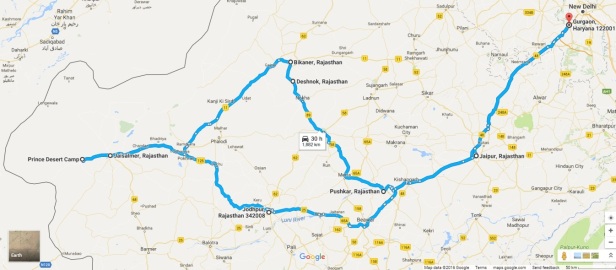
First leg of the Rajasthan road trip: Gurgaon to Jodhpur
We got up really early on 27th Feb morning, around 3:30 am to complete all last minute preparations and at around 4:30 am managed to get my 18 months old daughter in the car from the bed without disturbing her sleep. I wanted to leave as early as possible from Gurgaon so that i could cross Jaipur and reach Ajmer and halt for breakfast around 9 am. Tip: Hence i had stacked up most things like food supplies, water, luggage etc in the car the night before. Also had refueled the car, air pressure checked in advance and updated the USB drive with latest music. Most roads in Rajasthan are like cake – smooth and absolute drivers paradise.
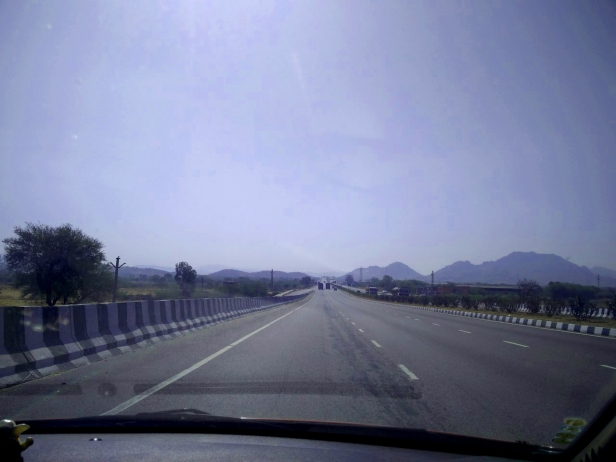
The distance between door to door (from home in Gurgaon to the hotel in Jodhpur) was 570.5 kms to be precise. The idea was to drive non-stop till Ajmer, distance to be covered was 370 kms. Tip: Our analysis told us that NH8 was the best route to be taken till Beawar and then NH25 from Beawar to Jodhpur. Our prior analysis also told us that typically the traffic on highways is lowest early morning after 4 am until 10 am as the truck drivers go off to sleep at around 4 am and only resume around noon. Hence this 6 hours window was what we wanted to make use of to the fullest.
As planned, we crossed Ajmer around 9:30 am and now TD felt a turmoil in the stomach acids and badly wanted to grab something to eat. We located a road side dhaba and stopped to have the first meal of the day. After a sumptuous breakfast and check-in on facebook we were back on the highway at 10 am.
We crossed Beawar and took a diversion from highway NH8 to NH25. NH25 takes you through a good patch of rocky mountains on both sides of the highway and drive gets scenic.
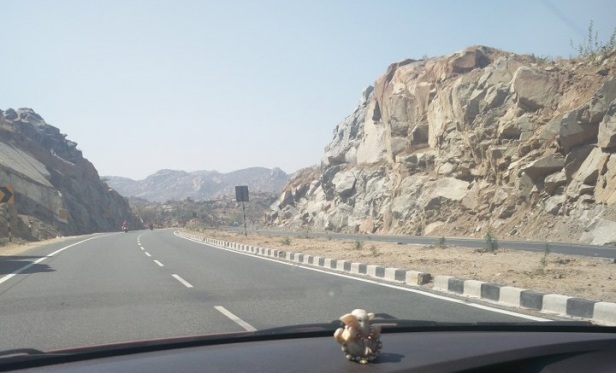
We checked into the hotel in Jodhpur around 2:30 pm. It was a drive of 570 kms in 9 hours, my personal best when it comes to distance vs drive time. We had chosen an inexpensive hotel (Superior room for about 3k rs per night) – The Prem Beacon for our stay (Pros – proximity to key areas, new construction, ample parking /Cons – No restaurant, not very great view). We quickly had Rajasthani thali from the hotel kitchen and went off to sleep. Got up at around 6 PM and went to Nai sarak. Visited the Ghanta ghar (Clock tower) which is on one end of the Nai sarak. It is a pretty old monument nicely maintained and looks attractive in the evenings due to the multi-color changing light effect on it. Tip: visit in the evening.
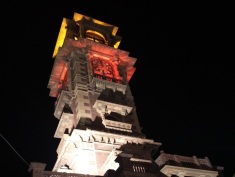
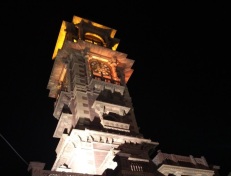
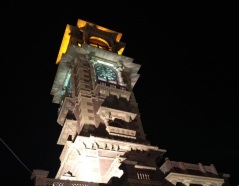

After few clicks we went on to explore Nai sarak famous for traditional rajasthani stuff like handicrafts, clothing and ofcourse food. To strike a good deal you really have to be a very good negotiator as the stuff is mostly priced 3 -4 times the actual cost. We spent some time shopping till the time we got hungry. Tip: Our analysis had told us that there are 2 must try dinning options – Janta sweet home and Priya restaurants on Nai sarak. We tried the famous Makahniya lassi, Matka rasmalai, Double cheese pizza, Pyaaz kachori, Rajkachori with a distinct Kesar yogurt. Yes, we ate it all – Absolutely lip smacking stuff! It is also recommended to have Mirchi bada and Mawa Kachauri here.
28th Feb – 2nd day of roadtrip: Next day we went to Umaid bhawan palace and museum. Tip: We did a guide at a very reasonable rate of 100 rs who briefed us pretty well. Museum is nicely done portraying the history of royal family of Jodhpur, very good collection of vintage cars and clocks. The palace is bifurcated into 3 parts. Royal family still resides in the left part, center part belongs to the Museum and right part is converted into a luxury hotel by Taj.
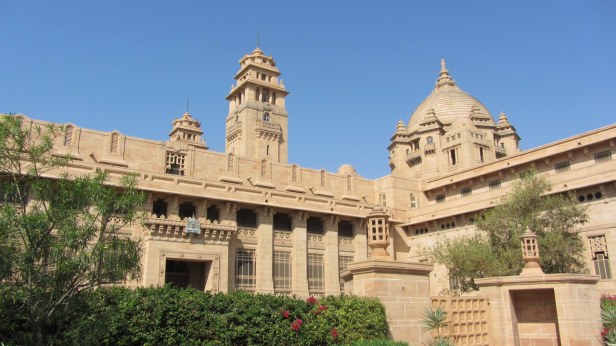
Next we went to Jaswant thada – Its an epitome of serenity. There is a lake on top of the hill. We sat there for sometime and experienced the quietness, cool breeze and the calmness imparted to the body.
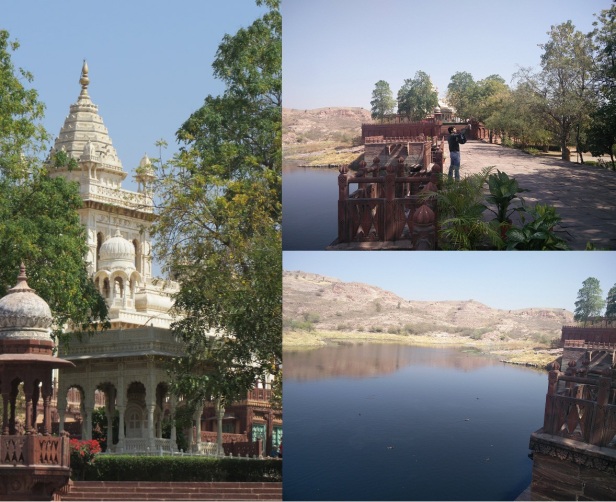
It was 2 pm by now and quite hot even though it was Feb. We planned to grab some food before we went ahead. Post sumptuous meals we went to Mehrangarh fort around 4 pm. Tip: we should have planned this as the first thing in the morning as it gets hot in the afternoon and its a decent steep walk up the hill from the parking. The fort is huge and also has a part of it converted into a museum – good museum again, specially the weapons section and the top level terrace finally tells us why its called the blue city. The view is breath taking, however the blueness has faded and reduced with time.
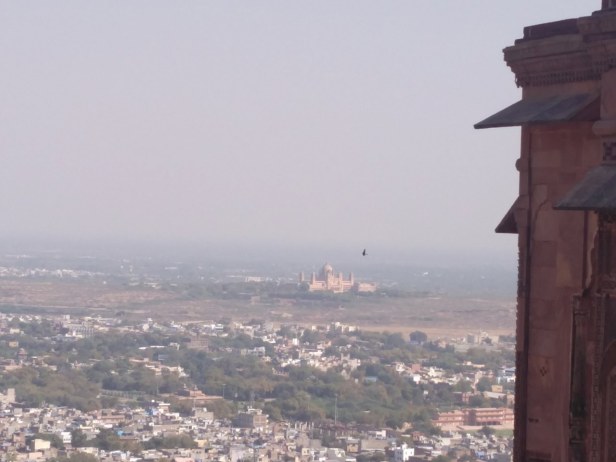
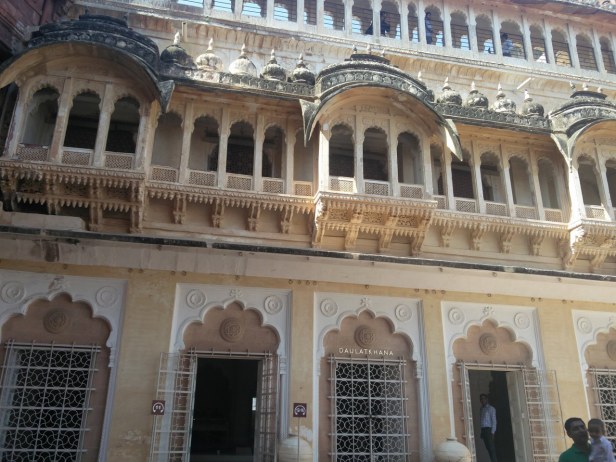
We came back to our hotel and took some rest. In the evening around 8 pm we decided to go back to Nai sarak. This time we went to Priya restaurant which is right opposite to Janta sweet home. We relished Pavbhaji, Batata papdi chat and Dosa which were quite tasty as well. We decided to do another round of Janta sweet home, this time only for Makahniyan lassi.We came back to hotel around 10:30 pm and went to sleep early as we had to leave for Jaisalmer early morning the next day!
Below is some key information from wikipedia and other sources on the monuments we visited.
Ghanta Ghar was constructed by the Late Shri Sardar Singh Ji of Jodhpur. Beside the tower, there is the Sadar Market that is frequented by tourists on shopping spree. From this market, tourists can purchase Rajasthani textiles, clay figurines, miniature camels and elephants, marble inlay work and classic silver jewellery.
Umaid Bhawan Palace was called Chittar Palace during its construction due to use of stones drawn from the Chittar hill where it is located. History of building the Umaid Bhawan Palace is linked to a curse by a saint who had said that a period of drought will follow the good rule of the Rathore Dynasty. Thus, after the end of about 50-year reign of Pratap Singh, Jodhpur faced a severe drought and famine conditions in the 1920s for a period of three consecutive years. Ground for the foundations of the building was broken on 18 November 1929 by Maharaja Umaid Singh and the construction work was completed in 1943. The Palace was built to provide employment to thousands of people during the time of famine. About 2,000 to 3,000 people were employed to build it. The building material required was not close by as sandstone quarries were at quite a distance. Since the Maharaja had the foresight to bring his project to fruition, he built a railway line to the quarry site to transport the building material. Donkeys were inducted to haul soil to the site. The sandstone transported by rail was dressed at site into large blocks with interlocking joints so that they could be laid without the use of mortar and thus create a wonderful edifice. The palace was built with “dun-colourd” (golden – yellow) sandstone with two wings. Makrana marble has also been used, and Burmese teak wood has been used for the interior wood work. The estimated cost of building the palace was Rs 11 million. When it opened its gilded doors in 1943 it was considered as one of the largest royal residences in the world.
The Jaswant Thada is a cenotaph. It was built by Maharaja Sardar Singh of Jodhpur State in 1899 in memory of his father, Maharaja Jaswant Singh II and serves as the burial ground for the rulers of Marwar. The mausoleum is built out of intricately carved sheets of marble. These sheets are extremely thin and polished so that they emit a warm glow when illuminated by the sun. The cenotaph’s grounds feature carved gazebos, a tiered garden, and a small lake. There are three other cenotaphs in the grounds. The cenotaph of Maharaja Jaswant Singh displays portraits of the rulers and Maharajas of Jodhpur.
Mehrangarh fort – Rao Jodha founded Jodhpur in 1459. He was one of Ranmal’s 24 sons and became the fifteenth Rathore ruler. The foundation of the fort was laid on 1/ May 1459 by Jodha on a rocky hill. This hill was known as Bhaurcheeria, the mountain of birds. According to legend to build the fort he had to displace the hill’s sole human occupant, a
hermit called Cheeria Nathji, the lord of birds. Upset at being forced to move Cheeria Nathji cursed Rao Jodha with “Jodha! May your citadel ever suffer a scarcity of water!”. Rao Jodha managed to appease the hermit by building a house and a temple in the fort very near the cave the hermit had used for meditation, though only to the extent that even today the area is plagued by a drought every 3 to 4 years. Jodha then took an extreme measure to ensure that the new site proved propitious; he buried a man called “Raja Ram Meghwal” alive in the foundations. “Raja Ram Meghwal” was promised that in return his family would be looked after by the Rathores. To this day his descendants still live in Raj Bagh, “Raja Ram Meghwal’s” Garden, an estate bequeathed them by Jodha. Entry to the fort is gained though a series of seven gates. The most famous of the gates are:
- Jai Pol (“Gate of Victory”), built by Maharaja Man Singh in 1806 to celebrate his victory in a war with Jaipur and Bikaner
- Fateh Pol, built to celebrate a victory over the Mughals in 1707
- Dedh Kamgra Pol, which still bears the scars of bombardment by cannonballs
- Loha Pol, which is the final gate into the main part of the fort complex
Immediately to the left are the handprints (sati marks) of the ranis who in 1843 immolated themselves on the funeral pyre of their husband, Maharaja Man Singh. Within the fort are several brilliantly crafted and decorated palaces. These include, Moti Mahal (Pearl Palace), Phool Mahal (Flower Palace), Sheesha Mahal (Mirror Palace), Sileh Khana and Daulat Khana. The museum houses a collection of palanquins, howdahs, royal cradles, miniatures, musical instruments, costumes and furniture. The ramparts of the fort house preserved old cannon (including the famous Kilkila), and provided a breath-taking view of the city.
Note: Please feel free to asks any queries or provide your views or feedback on the blog. I will respond to you as soon as possible 🙂
Lot of information and precise. Thanks for sharing.
LikeLiked by 2 people
Welcome Neha 🙂
LikeLike
Thankyou!
LikeLike
Nice read! Part 1 done, on to next now.
LikeLiked by 2 people
Sure, thanks Ajay 🙂
LikeLike
Bhai, very nicely explained… I can feel how much u enjoyed…
LikeLiked by 1 person
Yea, that’s true. Thanks 🙂
LikeLike
Interesting read! 🙂
LikeLiked by 1 person
Thanks 🙂
LikeLike
nice article
LikeLiked by 2 people
Thanks Shib, glad you liked it!
LikeLiked by 1 person
beautiful simply beautiful frlt as if i traveled myself really njoyed it
LikeLiked by 2 people
Thanks Limara, glad you could connect to it and liked it!
LikeLike
Beautiful photos that have captured the essence of your trip. And of course, your words are very descriptive and tempting 🙂 Thanks for stopping by my blog and bringing me here!
LikeLiked by 2 people
Your welcome Arjun, and thanks for liking the blog 🙂
LikeLiked by 1 person
I will note for next trip to go here
LikeLiked by 2 people
Great Viva!
LikeLike
Hello, Thanks for sharing such a fantastic blog.I really appreciate your blog to share information about Rajasthan …Visiting in Rajasthan is amazing experience.Royal Rajasthan is not only the the land of Kings but also famous in tourist destinations in all over the India. Rajasthan is only one of the place where tourists can enjoy with many of things such as culture, civilizations, history, fairs & festivals, Songs & dances, food, forts, temples, lakes, hills and natural beauty with adventure tours. best blog…
LikeLiked by 1 person
Virasat looks amazing, I will surely visit in my next trip to Jaipur
LikeLike
I totally agree with you. Many thanks for the kind words 🙂
LikeLike
Delightful photographs that have caught the embodiment of your trek. What’s more, obviously, your words are extremely enlightening and enticing 🙂 Thanks for ceasing by my blog and bringing me here!
LikeLiked by 1 person
Thanks Ashley, glad you liked my blog 🙂
LikeLike
Hi, Thanks for sharing such an awesome blog.I truly value your blog to share data about Rajasthan … Visiting in Rajasthan is astonishing experience.Royal Rajasthan is the place where there is Kings as well as renowned in visitor goals in everywhere throughout the India.
LikeLiked by 1 person
Completely agree, Rajasthan is the place to be if you enjoy royalness and history!
LikeLike
nice blog keep posting such amazing blogs
LikeLiked by 1 person
Thanks you, glad you liked it 😀
LikeLike